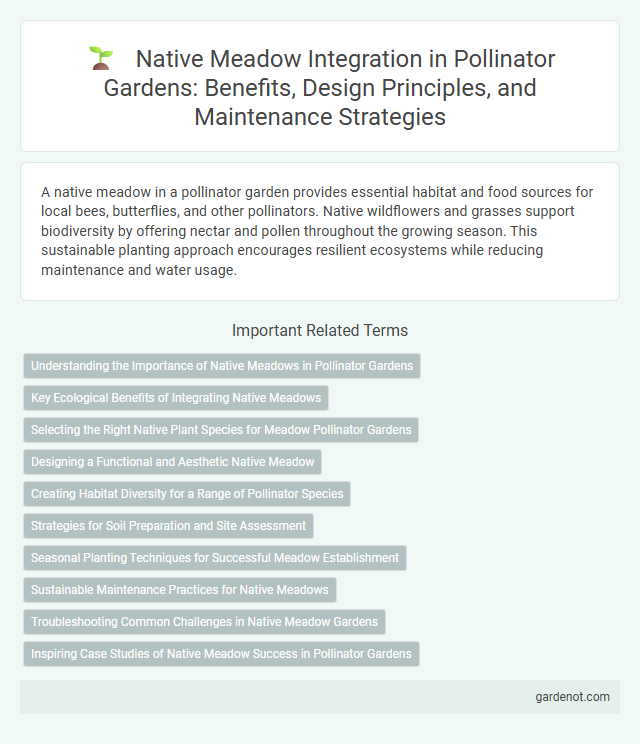A native meadow in a pollinator garden provides essential habitat and food sources for local bees, butterflies, and other pollinators. Native wildflowers and grasses support biodiversity by offering nectar and pollen throughout the growing season. This sustainable planting approach encourages resilient ecosystems while reducing maintenance and water usage.
Understanding the Importance of Native Meadows in Pollinator Gardens
Native meadows provide essential habitats rich in biodiversity, supporting a wide range of pollinators including bees, butterflies, and hummingbirds. Their diverse native plant species offer continuous nectar and pollen sources throughout the growing season, crucial for sustaining pollinator populations. Integrating native meadows into pollinator gardens enhances ecosystem resilience and promotes natural pollination processes vital for both wild and agricultural plant productivity.
Key Ecological Benefits of Integrating Native Meadows
Native meadows provide essential ecological benefits by supporting diverse pollinator populations, including bees, butterflies, and other beneficial insects. Their deep-rooted native plants enhance soil health, improve water retention, and reduce erosion, contributing to ecosystem stability. Integrating native meadows into pollinator gardens promotes biodiversity, fosters habitat connectivity, and increases resilience against climate change.
Selecting the Right Native Plant Species for Meadow Pollinator Gardens
Selecting the right native plant species for meadow pollinator gardens is crucial for supporting local ecosystems and attracting diverse pollinators like bees, butterflies, and hummingbirds. Opt for native wildflowers such as purple coneflower (Echinacea purpurea), black-eyed Susan (Rudbeckia hirta), and blue wild indigo (Baptisia australis), which offer essential nectar and pollen resources throughout the growing season. Incorporating a variety of bloom times ensures continuous food supply, enhancing pollination efficiency and promoting biodiversity.
Designing a Functional and Aesthetic Native Meadow
Designing a functional and aesthetic native meadow involves selecting an appropriate mix of indigenous wildflowers and grasses that support local pollinators such as bees, butterflies, and hummingbirds. Incorporating diverse plant heights and bloom times ensures continuous nectar sources while creating visually appealing patterns that attract wildlife and enhance biodiversity. Proper soil preparation and minimal maintenance practices promote sustainable growth and ecological balance within the pollinator garden.
Creating Habitat Diversity for a Range of Pollinator Species
Native meadows provide diverse floral resources and nesting sites essential for supporting a wide range of pollinator species, including bees, butterflies, and moths. Incorporating a variety of native grasses and wildflowers in different bloom periods ensures continuous food supply and habitat complexity. Habitat diversity in native meadows promotes pollinator health, enhances biodiversity, and supports ecological resilience in pollinator gardens.
Strategies for Soil Preparation and Site Assessment
Effective soil preparation for a native meadow in a pollinator garden begins with comprehensive site assessment, including soil texture, pH, nutrient levels, and drainage capacity. Strategies involve amending the soil with organic matter to enhance fertility and structure, while minimizing disturbance to maintain existing microbial communities crucial for native plant establishment. Proper site selection and preparation ensure optimal root development, water retention, and long-term sustainability of pollinator-friendly native vegetation.
Seasonal Planting Techniques for Successful Meadow Establishment
Native meadow establishment thrives with precise seasonal planting techniques, ensuring optimal germination and growth of native grasses and wildflowers. Early spring or fall sowing aligns with natural moisture cycles, promoting deep root development and resilience. Incorporating diverse native species staggered by bloom times sustains pollinator activity throughout the growing season, enhancing biodiversity and ecosystem stability.
Sustainable Maintenance Practices for Native Meadows
Sustainable maintenance practices for native meadows emphasize minimal intervention to preserve biodiversity and soil health. Techniques such as selective mowing, controlled grazing, and seasonal prescribed burns promote native plant regeneration and support pollinator habitats. Incorporating organic mulching and avoiding chemical fertilizers further enhances ecosystem resilience and long-term meadow sustainability.
Troubleshooting Common Challenges in Native Meadow Gardens
Native meadow gardens often face challenges such as invasive weeds, insufficient native seed germination, and soil nutrient imbalances. Effective troubleshooting includes implementing targeted weed control methods, improving seedbed preparation for better germination, and conducting soil tests to adjust nutrient levels. Monitoring plant health closely and adapting management practices ensures the success and sustainability of native meadow pollinator habitats.
Inspiring Case Studies of Native Meadow Success in Pollinator Gardens
Native meadows in pollinator gardens provide essential habitats that increase biodiversity and support local pollinator populations such as bees, butterflies, and hummingbirds. Successful case studies from regions like the Midwest and Pacific Northwest demonstrate increased pollinator visitation rates and improved native plant health when native grasses and wildflowers are prioritized. These examples highlight how integrating native meadow ecosystems enhances ecological resilience and promotes sustainable pollinator-friendly environments.
Native meadow Infographic

 gardenot.com
gardenot.com